There is an excellent new book “The R& V Story” recently published by Donald Paul and John Nikodym. I would encourage anyone wanting a more in depth look at the cars, company, people, more cars and engines involved to check out the book. At 270 pages, it offers far more than the glimpse I can provide here.This is a condensed form of an article I wrote for Vintage Tractor Digest in 2017 as part of a series on early Tri Cities (Moline, Rock Island, Davenport and surrounding, now the Quad Cities) tractor and engine companies. At least two Rock Island Branch Houses (Southern and Eastern) sold R&V from 1909-1911, making the R&V/RIPC relationship relatively minor for both companies.
In May of 1899, Orlando J Root and William H Van Dervoort formed the Root & Van Dervoort Engineering Company in Champaign IL. The pair rented space on the 2nd floor of the Champaign Machine & Supply Company to manufacture under license the Sweeny Locomotive Nozzle for the rail industry. The Sweeny nozzle was a device installed in the stack of a locomotive that regulated airflow coming from the boiler (which reduced power and fuel use when in use). The device proved fairly popular at the time and in 1900 Van Dervoort traveled to Europe to look into the manufacture of flexible steel hose for locomotive brake lines. A news paper article on his return suggested a new company would be formed taking over the Champaign Machine & Supply Co factory, much to the surprise and unhappiness of the owner of the company. While nothing ever developed of that venture, it likely put a strain on R&V’s use of the facility.
In May 1900, the Root & Van Dervoort Engineering Co incorporated, still with the purpose of manufacturing specialty locomotive parts. Although a number of sales of the Sweeny nozzle were made, it had fallen out of favor due to its need for excessive maintenance. Needing a new product, in October 1900 the company announced it was entering the stationary engine market with a 2 hp vertical design for pumping and 2.5, 5 and 8 hp horizontal designs marketed for running generators. A series of marine engines in four sizes was announced in December.
The engines were an immediate success and almost immediately orders outstripped the capacity of the rented space. In April 1901, it was announced that the company would be moving to East Moline, Il into the old Western Stamping Co factory which included its own foundry. 40-50 men would be employed to build two engines a day when the factory opened in May. In June, the workforce went on strike, but the company refused to negotiate and in a few days operations resumed. R&V had had a policy in Champaign to not allow unions and would continue that philosophy. By the time the factory in Champaign had been dismantled and moved in July, 44 engines had been built there.
In 1902 Root & Van Dervoort entered into an agreement with another local company, John Deere. Deere would market the R&V out of their Minneapolis Minnesota Deere & Webber branch house, which was a major coup for the still young company. In those days of slow travel and communication, each branch house for a company served as a regional headquarters, often making their own decisions on stock and on “jobbing” or carrying another companies products. These branch houses would direct an army of regional salesmen and provide support to the many small town merchants that carried the companies goods; to be a branch house manager was to be a well regarded and entrusted senior executive. R&V couldn’t have hardly hoped to break into a better market than the large and lucrative northern territories the Minneapolis branch house serviced.
Demand again exceeded production and in December 1902 a plant expansion was begun, which was soon completed. To commemorate, a dance was held for the now 55 employees and their spouses in the new building and the streetcars ran late to ferry the party goers home.
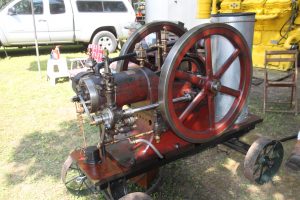 By 1904, the companies engine line consisted of the horizontal 3 hp weighing 565 pounds on up to a 6,200 pound 25 hp engine in 3, 5, 8 10, 14, 16 and 25 hp sizes. The vertical line consisted of 1,2,3, and 6 hp models. Although the smaller sizes would be popular for many purposes on a farm, the largest models were for industrial uses. 1904 was a significant year for the company as it was apparent they would soon run out of capacity and a new venture was to be added to the company, the production of an automobile under the Moline Automobile Company name. The new company would share resources and executives, but would be managed separately. The new Molines were also a hit, with a number of prominent local figures placing orders, including Deere, Moline Plow Co and Moline Wagon Co executives. Again demand outstripped production, as the planned 15 autos produced a month was in no way sufficient to meet the orders that were rolling in for the Moline, and in fact in all of 1904 only 19 were actually produced.
By 1904, the companies engine line consisted of the horizontal 3 hp weighing 565 pounds on up to a 6,200 pound 25 hp engine in 3, 5, 8 10, 14, 16 and 25 hp sizes. The vertical line consisted of 1,2,3, and 6 hp models. Although the smaller sizes would be popular for many purposes on a farm, the largest models were for industrial uses. 1904 was a significant year for the company as it was apparent they would soon run out of capacity and a new venture was to be added to the company, the production of an automobile under the Moline Automobile Company name. The new company would share resources and executives, but would be managed separately. The new Molines were also a hit, with a number of prominent local figures placing orders, including Deere, Moline Plow Co and Moline Wagon Co executives. Again demand outstripped production, as the planned 15 autos produced a month was in no way sufficient to meet the orders that were rolling in for the Moline, and in fact in all of 1904 only 19 were actually produced.
In 1905 the company again moved, this time only a few blocks farther down to a new, much larger factory that had been constructed for the two companies. The new facility tripled the the number of moulders at the new foundry and the increased capacity finally allowed the company to meet its casting needs. The new Model B touring car and Model D runabout proved popular at the 1905 Chicago Auto Show for their styling and top quality and orders continued to roll in despite still slow production. Along with car orders, engine orders were also coming in at a rapid pace necessitating a second shift be added to the engine production line. At this time, the engines themselves were painted a deep maroon color with yellow pin striping. All in all, a handsome engine. Four styles of engine were offered: the vertical style using a single governor weight on the flywheel, a marine engine, a volume governed design that persisted through 1918 that utilized an open fly ball governor and a hit & miss style that had been introduced in 1904 to address the mid priced market that used a headless design that mostly used the single weight governor.
With the company now producing 200-250 engines and the production of the Moline automobile finely starting to hit its stride, by the end of 1906 yet another major expansion of the factory had been undertaken with the plan to triple capacity for both the engine company and the automobile company.
Labor issues had continued to simmer in the Tri Cities during 1906, but in January 1907 things came to a boil when 30 key foundry men walked out of the job on strike. Soon similar walkouts had spread to other Moline companies. The response was swift and an offer for $4 a day was circulated in Chicago for skilled moulders. This was a $1 a day more than normal wages and within two weeks strike breakers were arriving in town, where they were put up in a hotel and guarded by well armed former Chicago policemen. Each company was responsible for housing their new men, and R&V chose to house them in the factory. When cots being delivered for them were abandoned by a wagon driver unwilling to cross the strike line, Orlando Root drove the wagon in himself. Both Root and Van Dervoot were a staunchly anti union and Root swore there would be no union, and no man who carried a union card would be rehired. As the strike wore on, the Machinist Union also began to discuss strikes. Because of this,a group of R&V employees went to Root and asked to negotiate. Although they feared loosing their jobs and having to live on the $7 a week strike wages, they also feared being labeled as scabs for crossing a picket line. Root agreed with their concerns and suggested they should look for employment elsewhere for a time and he would write each a personal recommendation as a first class machinist as he hated to see them go, but he would not compromise to the unions. Root was not antiworker, as he was perfectly willing to negotiate with the men, but he saw the unions as an unnecessary evil.
As the strike wore into spring, the factory continued running with the brought in men and the majority of the workers who were not on strike. An estimate put the number of actual striking workers 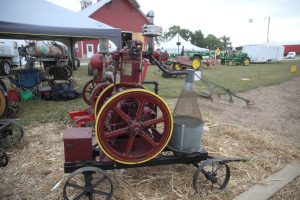 at only around 33 men. Some had left as conditions worsened, but the ones who remained had become increasingly violent. Van Dervoort had six guards sworn in as sheriffs deputies to protect his workers from the strikers. An attack on three workers riding the trolley home finally prompted action by local groups who sought to act as intermediaries between the factory and strikers. When they sat down with Van Dervoort, he told them under no circumstances would he speak with the union or employ a union man in his factory. Faced with this unwillingness to negotiate the group disbanded. Violence and even a case of gunplay continued when the union appealed ot the state to send arbiters to break the strike. The response from the manufacturers association of which R& V was part of was that there had been no negotiations or request from the association for state arbiters and that frankly, there was no business to discuss. In short order, the government men had board the train and left deciding there was nothing for them to do there. In July, Van Dervoort filed for an injunction against the strikers with 140 pages of affidavits of employees attesting threats and violence made against them by the strikers. Although the union fought it, the issue was decided quickly in the courts and an injunction was issued against the strikers. With no ability to picket and their jobs already replaced, the strikers faded away.
at only around 33 men. Some had left as conditions worsened, but the ones who remained had become increasingly violent. Van Dervoort had six guards sworn in as sheriffs deputies to protect his workers from the strikers. An attack on three workers riding the trolley home finally prompted action by local groups who sought to act as intermediaries between the factory and strikers. When they sat down with Van Dervoort, he told them under no circumstances would he speak with the union or employ a union man in his factory. Faced with this unwillingness to negotiate the group disbanded. Violence and even a case of gunplay continued when the union appealed ot the state to send arbiters to break the strike. The response from the manufacturers association of which R& V was part of was that there had been no negotiations or request from the association for state arbiters and that frankly, there was no business to discuss. In short order, the government men had board the train and left deciding there was nothing for them to do there. In July, Van Dervoort filed for an injunction against the strikers with 140 pages of affidavits of employees attesting threats and violence made against them by the strikers. Although the union fought it, the issue was decided quickly in the courts and an injunction was issued against the strikers. With no ability to picket and their jobs already replaced, the strikers faded away.
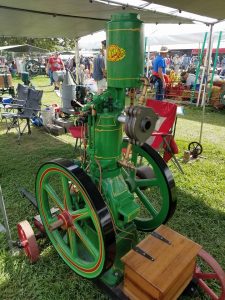 Although production had increased substantially, by July of 1908 the Moline Automobile Company was still two months behind with substantial orders coming from the midwestern market. In October of 1908 the new Moline Model M, a 24 hp 4 cylinder car priced at $1,500 was announced. The model M would prove to be an incredibly popular car, in part because it could be ordered in two drive designs, a standard driven rear axle or with a chain drive running to each rear wheel.
Although production had increased substantially, by July of 1908 the Moline Automobile Company was still two months behind with substantial orders coming from the midwestern market. In October of 1908 the new Moline Model M, a 24 hp 4 cylinder car priced at $1,500 was announced. The model M would prove to be an incredibly popular car, in part because it could be ordered in two drive designs, a standard driven rear axle or with a chain drive running to each rear wheel.
In 1909 R&V added another dealer network to its line in the form of another local company, this time the Rock Island Plow Company. Rock Island at this point had not yet entered the powered equipment line, but their Indianapolis and Dallas branch houses were the first to enter the market by selling R&V’s into 1911. At this time, John Deere was still selling R&V’s through many of their branch houses and R&V had begun to ship a substantial number of engines to South America as well as sales through its own network of dealers. The automobile side had again outstripped capacity and R&V was looking for men to add to its already 300+ to add more shifts. Capacity had so been reached that the company was refusing to take on more dealers until more men could be added. For 1910 a new expansion was once again added and car production was approaching four cars per day, with the goal to ship 1,000 cars in 1910. The 1911 model M-35 was substantially redesigned and carried a new blue radiator name plate with white lettering proudly proclaiming the Moline Dreadnought with a gold inlaid figure of a battleship.
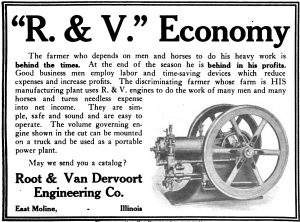 In 1911 R&V introduced a new line of engines, called the Triumph line. These were small, light weight hopper cooled engines in 1, 2, and 4 horsepower sizes. These engines also featured one of the most striking paint schemes of any engine. Sometime around 1909 the company had switched to the green paint commonly associated with R&V today. Gold and black pin stripping was used heavily to accent a very ornate R&V logo In gold, red black and green. These engines were often mounted on carts making them nicely portable for all the small chores around the farm like pumping water, running a saw or even running the missus washing machine. The Triumph line would prove so popular it would replace both the older style headless hit & miss style and the vertical line when 6, 8, 10 and 12 horsepower models were added the next year. These models would be called the L models and in 1915 the Triumph model R line was introduced. The R featured a less elaborate though still stylish paint scheme, a single weight governor, shorter base, varying sizes of flywheels and the cam gear was moved outside the frame. The model R would end up replacing the L line, although there was some overlap. The R’s were produced in a variety of sizes from 1hp to 20 hp. It is unknown if Rock Island ever sold any of the Model L engine.
In 1911 R&V introduced a new line of engines, called the Triumph line. These were small, light weight hopper cooled engines in 1, 2, and 4 horsepower sizes. These engines also featured one of the most striking paint schemes of any engine. Sometime around 1909 the company had switched to the green paint commonly associated with R&V today. Gold and black pin stripping was used heavily to accent a very ornate R&V logo In gold, red black and green. These engines were often mounted on carts making them nicely portable for all the small chores around the farm like pumping water, running a saw or even running the missus washing machine. The Triumph line would prove so popular it would replace both the older style headless hit & miss style and the vertical line when 6, 8, 10 and 12 horsepower models were added the next year. These models would be called the L models and in 1915 the Triumph model R line was introduced. The R featured a less elaborate though still stylish paint scheme, a single weight governor, shorter base, varying sizes of flywheels and the cam gear was moved outside the frame. The model R would end up replacing the L line, although there was some overlap. The R’s were produced in a variety of sizes from 1hp to 20 hp. It is unknown if Rock Island ever sold any of the Model L engine.
For 1912 the R&V made a major change in operations. Deere had for a time been pushing R&V to expand still farther and market their engines exclusively through the Deere distribution network. Van Dervoort had been extremely reluctant to take on substantial debt, but Deeres offer of 12.5% guaranteed over cost on the entire out put of engines was finally enough to get the deal done. Its entirely possible that the Rock Island Plow Company also selling R&V engines may have pushed Deere to finally sweeten the offer but it now linked R&V and Deere inseparably. Sales of engines for Deere and R&V in 1913 exceeded $1 million dollars before dropping back off. Although sales were brisk, for the first time production exceeded sales and the workforce was reduced to compensate. Although the situation was in no way bad for the company, the market had begun to substantially change. Not only was the market being saturated by a vast variety of companies building single cylinder engines in all sizes, the day of the small tractor had dawned. The new light weight tractors that were replacing the massive steam and early gas dinosaurs of the prairie breaking era were also very affordable to the small farmer and could do any of the tasks a medium or large stationary engine could do on the farm with its belt pulley. In addition, they could replace a large portion of the horses work for not much more than a stationary engine. Small gas engines still had a place on the farm for light tasks, but the large engines were now only really suitable to near permanent roles. In addition, the electric motor would begin to replace the gas engine in the small roles.
More and more, R&V would focus on the automobile business which continued to boom and in 1913 The Moline Auto Company obtained a license to produce the sleeve valve Knight engines, developed by Charles Knight, an English inventor whose engines had become very well regarded as high performance precision machines. In November 1913, it was announced that R&V would now be producing the 1914 Moline-Knight automobiles. The company was immediate ly contacted by many interested parties wondering why the Knight engine had been chose and Van Dervoort’s reply was simply “the Knight motor represents progression”.
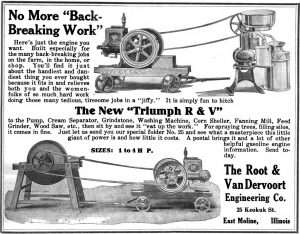 In January 1915, Van Dervoort was unanimously selected as the national president of the Society of Automobile Engineers in recognition of both his engineering and entrepreneurial skills. Two models of Moline Knights were to be produced that year, a $2500 50 hp model and a much more economical $1475 40 hp model that was probably targeted more at the rural customers R&V had already been selling to. 1915 also saw another major development in that R&V entered World War 1 early by taking on a contract to produce lathes for the British military to machine artillery shells for the war effort. Like many American companies at the time, R&V saw an opportunity in the war as Britain needed far more production than its own factories could produce and United States industry was hungry for the contracts. This would not be R&V’s last military contract, they would expand the factory to produce shells and later on guns for the war effort.
In January 1915, Van Dervoort was unanimously selected as the national president of the Society of Automobile Engineers in recognition of both his engineering and entrepreneurial skills. Two models of Moline Knights were to be produced that year, a $2500 50 hp model and a much more economical $1475 40 hp model that was probably targeted more at the rural customers R&V had already been selling to. 1915 also saw another major development in that R&V entered World War 1 early by taking on a contract to produce lathes for the British military to machine artillery shells for the war effort. Like many American companies at the time, R&V saw an opportunity in the war as Britain needed far more production than its own factories could produce and United States industry was hungry for the contracts. This would not be R&V’s last military contract, they would expand the factory to produce shells and later on guns for the war effort.
Although the war contracts and automobile company were still doing well in 1916, Deere canceled its contract with R&V in September citing high cost of the engines and complaints on quality. The Dallas, Omaha, Minneapolis, St Louis and Syracuse branch houses all negotiated individual contracts with R&V to keep selling engines. The Portland and San Francisco branch houses elected to sell Associated Mfg engines from Waterloo and Kansas City continued to sell Stover engines. Kansas City had been the only branch to not sell R&V’s previously, already having had a contract with Stover. The Moline and Indianapolis branches elected to not sell any engines at the time. Although a setback for the company, it was partially offset by strong sales in not just automobiles, but also in multi cylinder automobile and bus engines. One of the companies purchasing engines was the Moline Plow Company who chose to switch from Continental engines to 6 cylinder R&V Knight engines for its Stephens automobiles for 1917. The Moline Plow Company also purchased 4 cylinder engines for its new model Moline Universal D tractor (more on that in a future article).
When war was declared in 1917, William Van dervoort had already been appointed to the the US Munitions Standards Board, a group in charge of standardizing and evaluating munitions for the war effort. R&V would receive many war contracts and created the R&V – Wagner Ordinance Company to handle them in a new addition built across the road from the factory. Another major change occurred in October of 1917 when the Moline Automobile Company was merged into the Root & Van Dervoort Engineering Co, with the new company keeping the Root & Van Dervoort Engineering Co name with around 2,400 employees. Among these employees were a number of women, of whom Van Dervoort was one of the first to predict companies would be hiring to offset the men going to Europe to fight.
In April of 1918, the remaining Deere branch houses still selling R&V engines abruptly canceled their contracts. John Deere had purchased the Waterloo Gasoline Engine Company, and with it the Waterloo Boy tractors and gas engines. It s uncertain when the last R&V single cylinder engine was built as the bulk of the factory’s production had switched to building war material and a handful of Moline Knights and engines (mostly for farm tractors), but Deeres cancellation of the remaining contracts would have likely finished the line in any case.
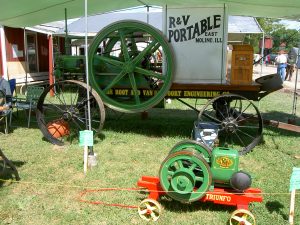 R&V would emerge from the war a thriving munitions, engines and automotive company; considered one of the major contributors of the war effort. This meant that R&V’s direct role in agriculture would now be limited to the the production of engines for the Moline Universal tractors. Although Van Dervoort was reluctant to take on major new contracts for a time due to rising labor tensions, in 1919 R&V accepted two contracts from Moline Plow Co for the Stephens Automobile and the Saxon Motor Company, each for 12,000 engines, which doubled the previous Moline Stephens contract. With a planned production total of 42,000 engines, R&V had become a major engine builder in the United States. No longer needed, the R&V Wagner Ordinance Company was dissolved and its building absorbed into R&V proper. For 1920’s automobile line, R&V finally abandoned the Moline – Knight brand and now called them the R&V Knight.
R&V would emerge from the war a thriving munitions, engines and automotive company; considered one of the major contributors of the war effort. This meant that R&V’s direct role in agriculture would now be limited to the the production of engines for the Moline Universal tractors. Although Van Dervoort was reluctant to take on major new contracts for a time due to rising labor tensions, in 1919 R&V accepted two contracts from Moline Plow Co for the Stephens Automobile and the Saxon Motor Company, each for 12,000 engines, which doubled the previous Moline Stephens contract. With a planned production total of 42,000 engines, R&V had become a major engine builder in the United States. No longer needed, the R&V Wagner Ordinance Company was dissolved and its building absorbed into R&V proper. For 1920’s automobile line, R&V finally abandoned the Moline – Knight brand and now called them the R&V Knight.
In early 1920, William Van Dervoort’s health worsened and he was forced to take a leave of absence. Van Dervoort had toured Europe after the war and had come back considerably weakened and now his heart began to trouble him. A critical decision was made to not appoint a replacement head for the company as it was hoped he would soon return to work. This would soon prove an issue as the company entered troubled times. The Moline Plow Company by mid year had drastically cut its orders for engines for both its automobiles and tractors and stopped tractor production entirely in July 1920 as the farm economy worsened and the Fordson tractor cut into everyone elses tractor sales. The Saxon contract was also calling for less motors than anticipated and by end of year had only produced 50% of their planned total of automobiles. R&V had considerably ramped up production in anticipation of these contracts and for the expected demand of the new R&V Knights. Both production and demand for the Knights had also lagged, with 5000 expected to be produced in 1920. This was a substantial amount as they had only approached 1000 built in previous years. The result was that substantial portions of the newly expanded factory now lay idle.
These expansions and changes had all been funded by a number of short term loans that had ballooned 1919’s debt from $750k to $3.1 million in 1920. In addition, the sudden slump of sales had taken inventory from almost nothing in 1919 to almost $4.5 million worth of unsold product. On July 26th, 1920, the banks stepped in and ordered changes. H.A Holder was appointed president. Orlando J Root and Rufus Walker Jr both resigned their positions as vice presidents of the company. A provision was retained that if Van Dervoort returned, he would take the position of chairman of the board, although this was now a mostly empty position with the banks firmly in charge. It wouldn’t matter, Van Dervoort would only visit the factory once more as his health deterorated.
One of the first changes by the new management was to split the company into a commercial motor division and an automobile division. The commercial motor division was soon announced to be a joint partnership with the Moline Plow Company, with each company having a 50% stake operating under the Moline Engine Company name. The Root and Van Dervoort Engineering Company would become a holding company for the R&V share of the Moline Engine Company and the new R&V Motor Company that the automobile division would become.
1921 would be a troubled year that started out with layoffs, shutdowns and an announcement of a general wage reduction. A general reorganization of its dealer network for its automobiles failed to produce an improvement in the general economic down turn and the prospects began to look grim for the R&V Motor company. On February 25th 1921, William H Van Dervoort succumbed to heart failure. In mourning, the plant was closed for the day of the funeral; in retrospect a fitting symbol of the link between the companies fortune and Van Dervoort’s leadership. Although Holder had been named president, he was only there to protect the banks interest. Orlando Root, perhaps for health or perhaps for temperament, had no interest in taking the reigns and no successor had been prepared. Soon after Van Dervoorts death, Root and other shareholders and the banks began to liquidate company assets. The Moline Plow Company, facing its own losses and rising debt and no help from its parent company, backed out of the Moline Engine Company leaving R&V the owners again. A deal in September of 1921 resulted in the Moline Plow Company purchasing the poppet valve engine machinery from the company in exchange for Moline Plow stock. This effectively ended the Moline Engine Company’s existence.
The remaining portion of the R&V companies was now fully devoted to building and selling Knight sleeve valve engines and automobiles. Although the company faced stiff competition from the Willys Knight company (whose parent company Willys-Overland also now owned the Moline Plow Co), 1922 was not as bad for the company with the introduction of the Model H and deals made with the Yellow Coach Manufacturing Company of Chicago owned by John Hertz, owner of Yellow Cab for bus engines. On February 7th, 1923 a deal was announced for the sale of the 4 cylinder engine tooling, parts, inventory and designs and a 3 year lease of floor space to Hertze’s Yellow Sleeve Valve Engine Works Inc for $350,000 and an option to buy the plant. This would leave R&V only producing the 6 cylinder engines and their automobiles. The deal allowed a significant amount of debt to be resolved and reduced employees at the plant to only 150. In May 1923, R&V liquidated its Moline Plow Company stock and for the first time in years was debt free, though now only a shadow of the 1919 company as by this time many of the former buildings of the sprawling factory network had already been sold off. A second major announcement in May was that Yellow Sleeve exercised an option to purchase the what remained of the R&V factory. R&V was granted 3 months of guaranteed space, but after that would be dependent on Yellow Sleeves space needs, the cost being $100,000 in cash and $225,000 in Knight Engines. Although $300,000 was initially secured in loans for relocation, it was eventually withdrawn due to concerns about the company and it is likely that at the August stockholders meeting the decision was made to liquidate the company. Although a fair bit of unsold inventory and parts remained, the company quickly began loosing employees. The R&V office building was sold to a local plumbing contractor in February 1924, although office space was leased back to the company. On September 4th, the last R&V Knights were built and the employees sent home for the last time. The former head of R&V’s service department Dan Smith bought the leftover parts and repair business to service the R&V knights still on the road and the last cars were sold in October1924.